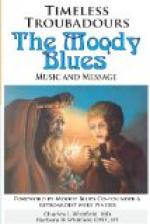Troubadour poems were composed for singing, not for recitation, and the music of a poem was an element of no less importance than the words. Troubadours are described as composing “good” tunes and “poor” words, or vice versa; the tune was a piece of literary property, and, as we have said, if a troubadour borrowed a tune he was expected to acknowledge its origin. Consequently music and words were regarded as forming a unity, and the structure of the one should be a guide to the structure of the other. Troubadour music is a subject still beset with difficulties[13]: we possess 244 tunes written in Gregorian notation, and as in certain cases the same poem appears in different MSS. with the tune in substantial agreement in each one, we may reasonably assume that we have an authentic record, as far as this could be expressed in Gregorian notation. The chief difference between Troubadour and Gregorian music lies in the fact that the former was syllabic in character; in other [27] words, one note was not held over several syllables, though several notes might be sung upon one syllable. The system of musical time in the age of the troubadours was based upon the so-called “modes,” rhythmical formulae combining short and long notes in various sequences. Three of these concern us here. The first mode consists of a long followed by a short note, the long being equivalent to two short, or in 3/4 time [Illustration: musical notation.]. The second mode is the reverse of the first [Illustration: musical notation.]. The third mode in modern 6/8 time appears as [Illustration: musical notation.]. The principle of sub-division is thus ternary; “common” time or 2/4 time is a later modification. So much being admitted, the problem of transposing a tune written in Gregorian notation without bars, time signature, marks of expression or other modern devices is obviously a difficult matter. J. Beck, who has written most recently upon the subject, formulates the following rules; the musical accent falls upon the tonic syllables of the words; should the accent fall upon an atonic syllable, the duration of the note to which the tonic syllable is sung may be increased, to avoid the apparent discordance between the musical accent and the tonic syllable. The musical accent must fall upon the rime and the rhythm [28] adopted at the outset will persist throughout the poem.
Hence a study of the words will give the key to the interpretation of the tune. If, for instance, the poem shows accented followed by unaccented syllables or trochees as the prevalent foot, the first “mode” is indicated as providing the principle to be followed in transposing the Gregorian to modern notation. When these conditions are reversed the iambic foot will prevail and the melody will be in the second mode. It is not possible here to treat this complicated question in full detail for which reference must be made to the works of J. Beck. But it is clear that the system above outlined is an improvement upon that proposed by such earlier students of the subject as Riemann, who assumed that each syllable was sung to a note or group of notes of equal time value. There is no evidence that such a rhythm was ever employed in the middle ages, and the fact that words and music were inseparable in Provencal lyrics shows that to infer the nature of the musical rhythm from the rhythm of the words is a perfectly legitimate method of inquiry.




